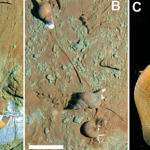 If you look at the Mediterranean Sea on a globe, you may get the impression that its just one contiguous water mass, but really its not. There are thirteen seas in the Mediterranean Sea. The Alboran Sea is the one closest to the Straits of Gibraltar, between Spain and Morocco. The Straits are shown in the lower left of the image. The Alboran Sea water mass is part of the western Mediterranean, separated from the eastern Mediterranean by a fluid boundary 200m thick called the Almeria Oran front. Below that fluid boundary lies a deeper colder layer, called Levantine intermediate water.
If you look at the Mediterranean Sea on a globe, you may get the impression that its just one contiguous water mass, but really its not. There are thirteen seas in the Mediterranean Sea. The Alboran Sea is the one closest to the Straits of Gibraltar, between Spain and Morocco. The Straits are shown in the lower left of the image. The Alboran Sea water mass is part of the western Mediterranean, separated from the eastern Mediterranean by a fluid boundary 200m thick called the Almeria Oran front. Below that fluid boundary lies a deeper colder layer, called Levantine intermediate water.
You must be geographically oriented in three dimensions before I can begin to explain “what’s a weddy?” A weddy in the Alboran sounds like fraternity prank out of JK Rowling’s Harry Potter or JRR Tolkien’s Middle Earth, I know, but this is the real world of physical oceanography. Field oceanographers are like “storm chasers”, seeking out ocean weather. Eddies, fronts, water masses, and water layers are their prey – the invisible features steering patterns of ocean circulation.
The Alberon Sea is important because it’s the only point of exchange between the Atlantic Ocean and the Mediterranean Sea. Deep salty water flows westward over the sill here and spreads across the most of the tropical Atlantic seafloor at 5000 m depth. Picture a giant under-waterfall. Meanwhile, shallow southbound Atlantic water from the North Atlantic gyre flows into the Med, adding a three-dimensional component to the smaller Alberon gyre bounded by the Aleria Oran front.
Within the gyre, National Oceanography Center of Southhampton UK researchers reporting in the Journal of Geophysical Research identified a discrete eddy of Western Mediterranean Intermediate Water they called a “weddy”. Repeated surveys allowed them to observe the evolution of the eddy over a period of 40 days. Think of it. They tracked a spinning water mass trapped between two water layers.
Discrete water masses like this are the rolling thunder in the oceans, the storms of the sea. Depending on how they spin, they can create a plankton bloom, or a downwelling. Eddies and weddys also retain and transport fish and invertebrate larvae, nutrients, and pollution for tens to hundreds of kilometers, so they are an important means of exchange between the Mediterranean Sea and Atlantic Ocean.
Picture a crew of meteorologists working by zeppelin from above the clouds rather than below. It’s a wild idea. Plus, it’s just really fun to talk about “intermediate water” and “fluid boundaries”. Especially if it involves giant swirling saltwater tornadoes with little or no surface expression, and… or, … am I alone on this one? I dunno. Me like weddys. Fluid dynamics are supercool.
Reference:
Allen, JT, SC Painter, M Rixen. 2008. Eddy transport of Western Mediterranean Intermediate Water to the Alboran Sea. Journal of Geophysical Research, Vol. 113, C04024, doi:10.1029/2007JC004649






The first time I’ve heard about the great oceanic cycle of water, those that carry heat from the equator to the poles, I was stunned by these colossal amounts. I’m with you.
Now, how come no one ever built water turbines before on the bottom of the ocean?
Because all of the wonderful designs which have been proposed would swiftly become fouled by settling organisms and rendered useless.
You made me smile bitterly. It’s sad how very good ideas are often flogged by reality. There’s an article on Wikipedia about biofouling. http://en.wikipedia.org/wiki/Biofouling